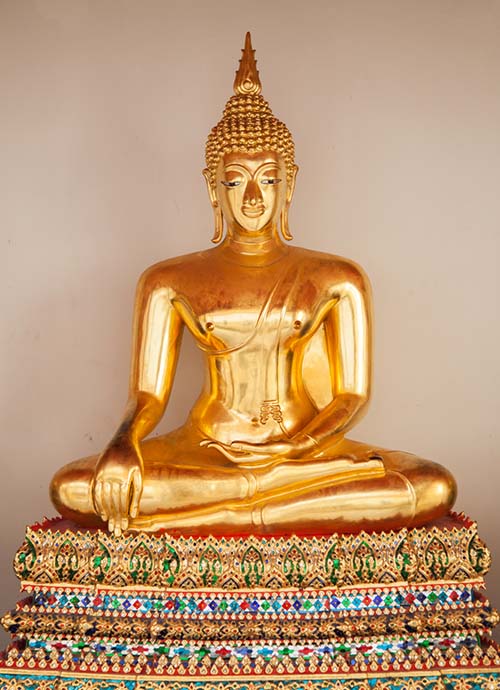
Subduing Mara
Meaning & origin of the earth touching mudra
Subduing Mara, also known as Calling the Earth to witness, Maravijaya and Bhumisparsha is by far the most often depicted mudra. The temple’s principal Buddha image, either in the viharn or in the ubosot, is often in this posture.
This mudra is only depicted on seated images, the legs crossed in meditation position, the right hand over the knee pointing towards the earth.
Meaning and origin of the subduing Mara mudra
The posture refers to an important event in the life of the Buddha. The Buddha-to-be was meditating under a Bodhi tree. Just before reaching enlightenment Mara the demon arrived accompanied by his armies and his three beautiful daughters. Mara’s armies attacked the Buddha while his attractive young daughters tried to distract and seduce the Buddha in order to stop him from meditating and reaching enlightenment.
The Buddha-to-be touched the Earth with his right hand, calling upon Mother Earth to be his witness. The earth Goddess Phra Mae Thorani appeared in the shape of a young, beautiful woman. By wringing the waters out of her long hair she drowned the armies of Mara, allowing the Buddha to continue meditating and reaching enlightenment. The story is seen depicted in murals in a great number of temples across Thailand.
Mara the demon
Mara the demon represents the opposite of the Buddhist teachings. The demon attempts to lure people into sin and temptation, to interest them in mundane and material things that last only a short while, as opposed to spiritual matters that are for ever. His three daughters represent lust, material wealth and temptation.
Famous Buddha images in subduing Mara posture
Some of the most famous Buddha images in subduing Mara mudra include Phra Buddha Chinnarat enshrined in the Wat Phra Si Rattana Mahathat in Phitsanulok and the golden Buddha of the Wat Traimit in Bangkok.
More mudras
Some other often seen mudras are: